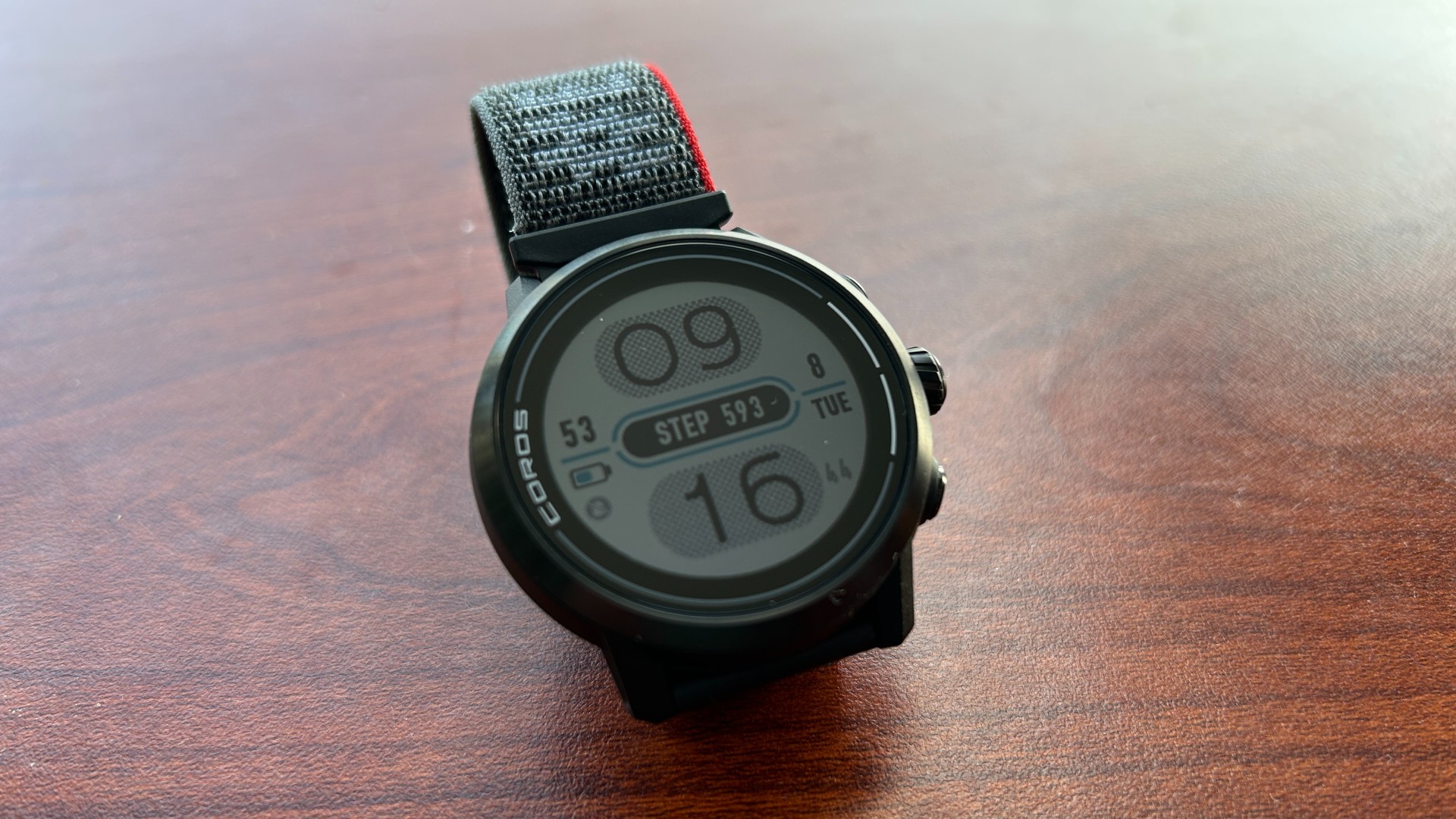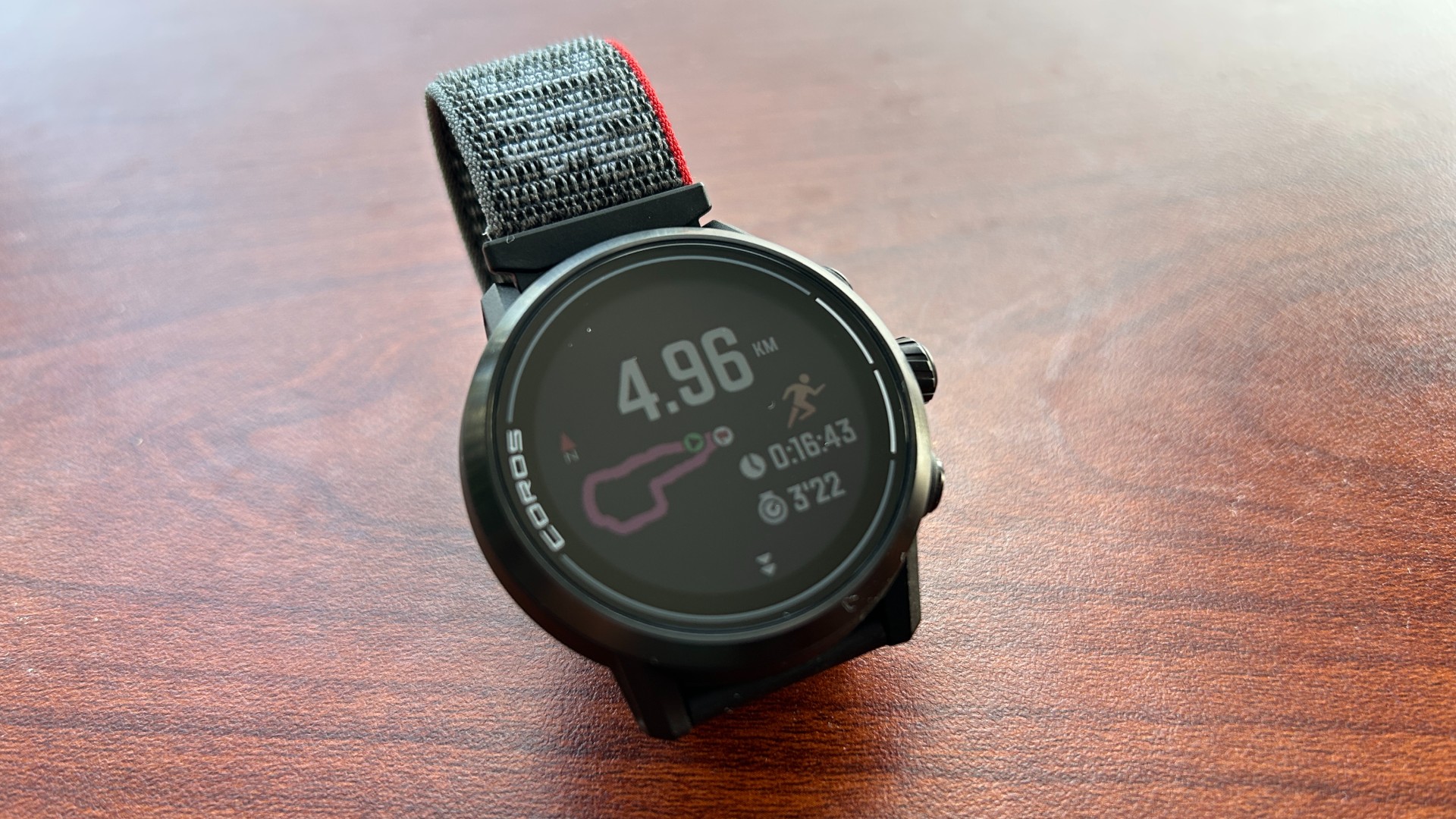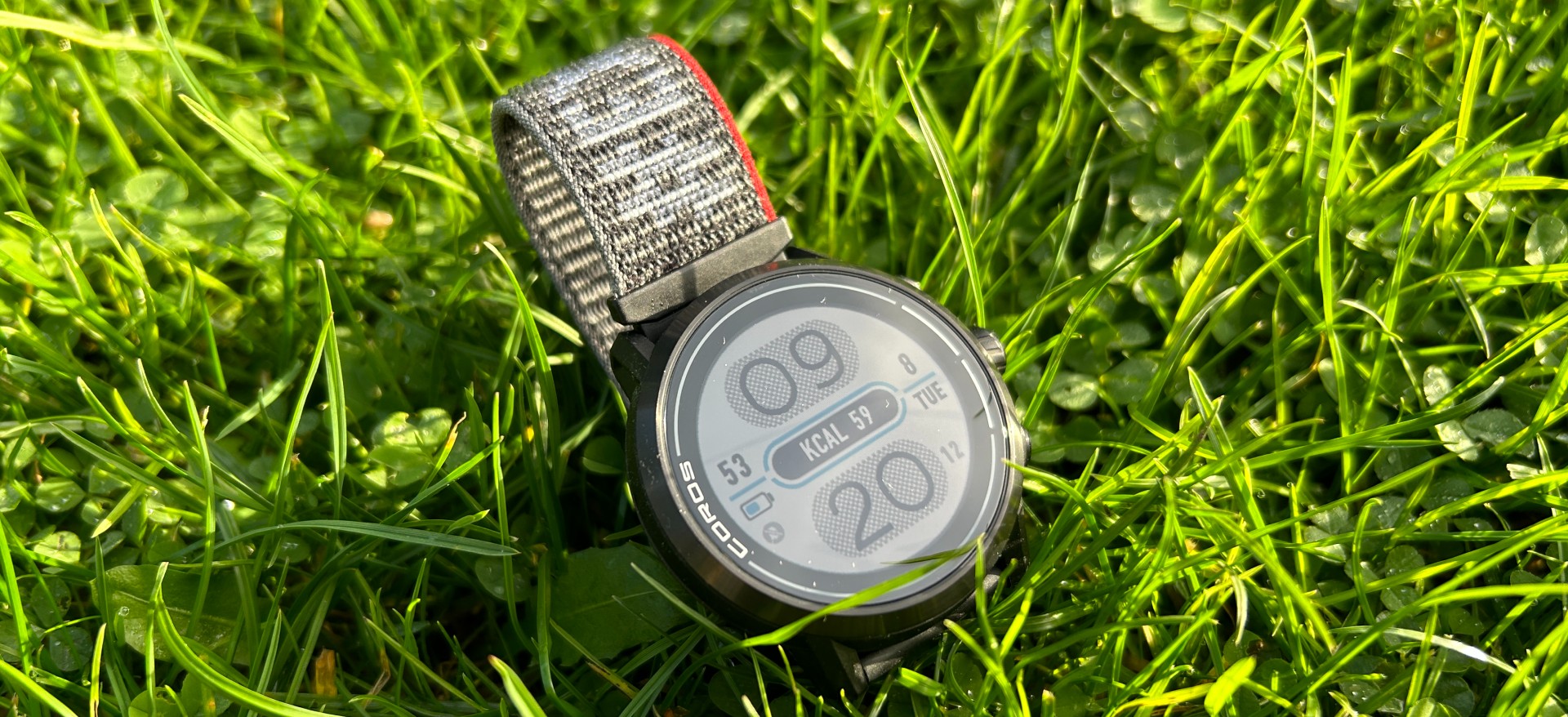Our Verdict
The Coros Apex 2 is a good sports watch with an attractive design, but like the Apex 2 Pro, it fails to offer a compelling alternative to Garmin watches at the same price.
For
- Attractive and rugged design
- Good battery life
- Navigation using colour maps
Against
- Iffy GPS accuracy
- Maps and music disappoint
- Price rise
You can trust Coach
The original Coros Apex was one of the best running watches, certainly in the value stakes, offering an attractive build and accurate tracking for under £300. It signalled that Coros represented a serious challenge to the established sports watch elite like Garmin and Polar with reliable devices that undercut the competition on price. With the subsequent Coros Pace 2, that challenge gained momentum.
Unfortunately, the Apex 2 feels like a step backwards in this regard, as does its sibling the Coros Apex 2 Pro. The Apex 2 has some useful updates, but the GPS accuracy seems to have gott worse with this generation, and a rise in price means it goes directly up against the Garmin Forerunner 255, which is a more accurate and impressive watch.
Coros Apex 2 Review: Price And Availability
The Coros Apex 2 was released in November 2022 and costs $399 in the US and £349 in the UK. That’s a rise in price on the original Coros Apex, which came in two sizes that cost $299/£269 for the 42mm watch and $349/£299 for the 46mm. The Apex 2 Pro launched at the same time as the Apex 2 and costs $499/£499.
Design

One area where the Coros Apex 2 outdoes its similarly priced competitors is in the quality of the materials used. It has a titanium-alloy bezel and a sapphire-glass touchscreen to help it stand out from the plastic devices you tend to find in its price range.
The Apex 2 has a 1.2in (30.5mm) screen, slightly smaller than the 1.3in (33mm) screen on the Apex 2 Pro, but the Apex 2 is a smaller, lighter watch overall, and a little more comfortable to wear.
Like other Coros watches, the Apex 2 uses a combination of buttons and dial to navigate its menus, rather than the five-button design that’s standard on Garmin and Polar devices. The dial works well once you get used to it, and the Coros user interface is simple to understand and use.
The Apex 2 has a 5 ATM waterproof rating, which is lower than the 10 ATM rating on the original Apex, though still more than enough for any activity most people are likely to undertake while wearing it. The Apex 2 has 8GB of storage, significantly less than the 32GB on the Apex 2 Pro, but enough to load up plenty of music and routes.
Coros has redesigned the antennae on the Apex 2 to offer more accurate GPS tracking, and the Apex 2 offers all-systems-on multi-GNSS tracking, although not the dual-band GPS you get on the Apex 2 Pro and Coros Vertix 2.
The Apex 2 has added a new heart rate sensor and can take heart rate variability (HRV) readings on demand, but it doesn’t measure this through the night like Garmin and Polar watches. It can also measure your blood oxygen saturation, and other sensors on board include a barometric altimeter and a compass.
How I Tested This Watch
I have been wearing the Coros Apex 2 for two weeks in combination with the Coros Apex 2 Pro and other watches like the Garmin Epix 2 and Apple Watch Ultra. I have tracked approximately six hours of running with it across eight runs, along with several indoor and outdoor rides, plus a couple of yoga sessions. I have also tested the original Coros Apex, along with the Coros Vertix 2 and Coros Pace 2 watches.
Sports Tracking
Coros offers a comprehensive sports tracking experience across its range, and really the only criticism I can level at it is that the experience is pretty much the same on the cheaper Pace 2 as it is on the more expensive Apex 2 and Vertix 2 watches.
Runners and triathletes get the most stats to pore over, and runners in particular get the most from Coros’s Evolab training analysis, which can help you ensure your overall training load is productive.
You can create structured workouts and entire training plans to follow on the Apex 2, and along with all the standard stats you’d expect, Coros offers running power measured from the wrist plus its new “effort pace” metric. This is designed to create a consistent pace reading you can use to judge your effort on hilly courses, with the incline taken into account so your effort pace will be faster than your actual pace on uphills, and vice versa on downhills.
Coros even suggests future updates will allow it to analyse your training and personalise effort pace, to take into account whether you’re a strong uphill runner. It’s a nice idea and a good alternative to power for those who want one metric they can use to gauge their effort across different runs, but effort pace doesn’t seem to take into account terrain – running up a muddy hill requires more effort than an asphalt one – and I’m still unconvinced of the need for extra effort stats. Pace, heart rate and running on feel all work perfectly well for me.
GPS And Heart Rate Accuracy

Although the Apex 2 does not have the dual-band GPS available on the Apex 2 Pro, I was expecting it to be pretty accurate with the multi-GNSS all-systems-on mode available, which uses five satellite systems at once.
However, I noticed significant corner-cutting on almost all my runs with the Apex 2. This resulted in some inaccurate lap pacing along with a shorter overall distance by the end of the run. It’s not terrible and will serve the needs of most runners well on most runs, but it’s certainly annoying when running on a looped course. It seems worse to me than the GPS accuracy of the Coros Pace 2, which doesn’t have multi-GNSS tracking.
Coros spearheaded advances in GPS accuracy by introducing multi-band on the Vertix 2, but so far Garmin and Apple watches that use the technology produce far more accurate results in my experience, while the Coros watches that use it don’t seem a considerable upgrade on older devices.
The heart rate accuracy on the Apex 2 was more impressive, reliably matching up to within a few beats of a chest strap on most runs. Even so, I still recommend linking to an external heart rate monitor if you’re planning to use the Coros training analysis, since the most accurate data going in will result in the best analysis coming out. You can link a heart rate monitor through Bluetooth, but not ANT+, even though ANT+ was available on the original Apex watches.
Maps And Navigation
The colour maps on the Apex 2 are a stand-out feature at its price – the other watches in this range offer only breadcrumb navigation. The maps don’t come preloaded as is the case on the Apex 2 Pro, but you can download them from the Coros website and then when you follow a route on the watch it will be overlaid on the map.
This is a useful upgrade on conventional breadcrumb navigation such as you’ll find on the Garmin Forerunner 255, where your route is shown on a blank background. However, the mapping features on the Coros are still a bit of a disappointment. There’s no turn-by-turn directions, though the watch will alert you if you stray too far off course, and in truth following a trail on a map is only a little easier than following it on a blank background, especially as watches like the Forerunner 255 do provide directions to alert you when turns are coming up.
At this price it’s still great to have maps, but I’d hope to see Coros update this feature to include directions, and also allow you to have a map screen on runs without needing to have a route loaded.
Garmin is still well ahead on mapping and navigation features, though you do have to spend more to get a Garmin watch with colour maps. The Garmin Forerunner 945 and Garmin Forerunner 955 both have them, along with the Fenix/Epix range and the Enduro 2.
Smart Features
There aren’t many smart features on the Coros Apex 2, which will mirror your phone’s notifications but doesn’t offer NFC payments, an app store or even a weather forecast. It does offer music storage so you can listen to music via Bluetooth headphones without having to carry your phone with you.
However, like maps, this is another feature which sounds better on paper than it is in practice. The watch doesn’t link to any streaming services (yet – Coros says it is working on this) so you have to drag and drop MP3 files onto the watch. If you have a huge library of MP3 files, congratulations. If not, then a Garmin watch that links to Spotify is probably going to be more useful.
Battery Life
Coros watches always impress on the battery front and the Apex 2 is no different. It is listed as lasting 17 days in smartwatch mode and offers 45 hours of standard GPS tracking, which drops to 30 hours in all-systems-on mode.
Between activities the battery level barely drops, partly because of the way it is set up to take heart rate readings only every 10 minutes by default, and also because the Apex 2 doesn’t do a lot outside of activities – there’s no HRV tracking at night for example.
However, it’s still impressive how long it lasts. The Apex 2 went 10-12 days between charges for me even when tracking outdoor runs almost every day.
Activity And Sleep Tracking
The Apex 2 tracks your steps, active minutes and floors climbed, and also monitors your sleep, providing a graph of your sleep stages in the morning.
It’s not a health watch and lacks the automatic HRV tracking that brands like Garmin and Polar use to gauge the overall condition of your body. If you can remember to do these each morning, you can use the readings to judge how hard to push in training each day. It’s a big “if” though – I rarely remembered to do them during the morning rush.
Is The Coros Apex 2 Worth It?
The Coros Apex 2 looks good and promises a lot on paper, but while it’s a great sports watch overall I found several frustrating aspects, notably the iffy GPS tracking. The maps and music features aren’t amazing, but the maps are still an upgrade on anything else you get on a watch at this price, including the Garmin Forerunner 255.
However, on most other fronts the Forerunner 255 wins out. It’s more accurate thanks to the multi-band GPS it offers, and the music version of the watch can link to Spotify plus other streaming services. The Apex 2 uses more impressive materials and offers longer battery life, but the Forerunner 255 is a more enjoyable and accurate tracker to use for serious training.
The Apex 2 is a better-value option than the Apex 2 Pro, because while the Pro has a longer battery life the standard Apex 2 model is still impressive here, and the multi-band GPS tracking on the Pro didn’t really end up being that much more accurate in its tracking (our Coros Apex 2 vs Coros Apex 2 Pro comparison goes into further detail). I still think the Coros Pace 2 is the pick of the line-up, however, since it offers everything Coros does best – detailed sports tracking, useful training analysis and good battery life – at a much lower price than the Apex 2. The Apex 2 has a better and hardier design, but the plastic Pace 2 is exceptionally light and quite appealing in its own way, and losing the maps and music you get on the Apex 2 isn’t a huge loss given the limitations.

Nick Harris-Fry is a journalist who has been covering health and fitness since 2015. Nick is an avid runner, covering 70-110km a week, which gives him ample opportunity to test a wide range of running shoes and running gear. He is also the chief tester for fitness trackers and running watches, treadmills and exercise bikes, and workout headphones.

